Transplanting peonies in the spring to another place
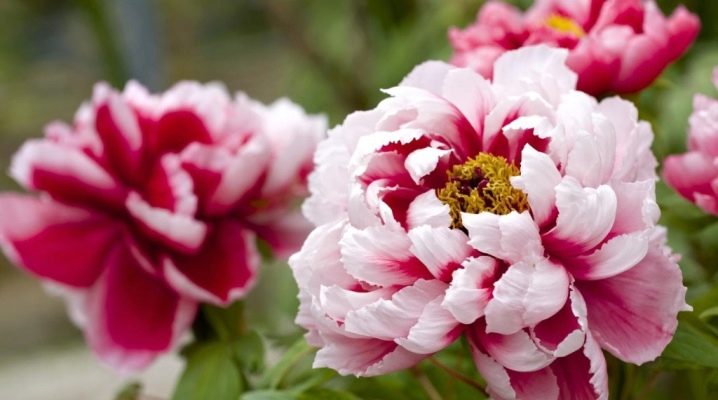
Experienced gardeners who grow perennial peonies know that in order to preserve their decorative appearance and ensure flowering, the plant must be transplanted from one place to another, at least once every 5 years. Autumn is traditionally considered the optimal time for such a transplant. This time of year was chosen for the reason that before the onset of spring, the peony bush manages to adapt to new conditions and take root well. Peonies have one feature - they really do not like transplants. However, this flowering perennial can be transplanted not only in the fall. If you approach the matter competently, then this procedure can be performed even in the spring.
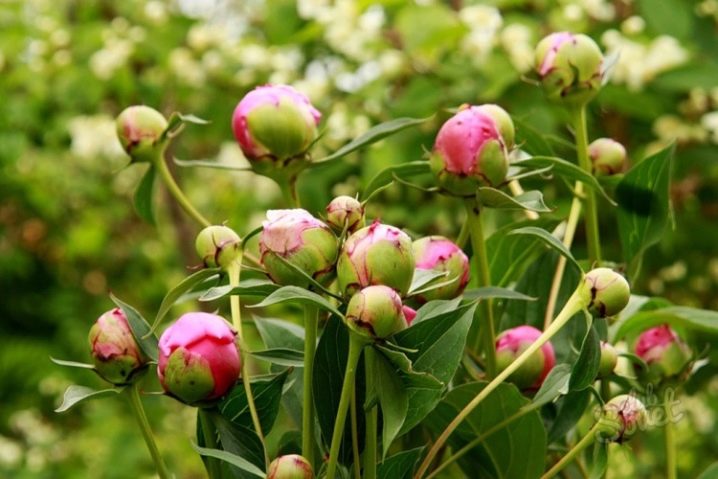
Description
Peony is a perennial flowering deciduous shrub. He is a representative of the Peony family, he belongs to the Buttercup family. This plant grows up to one meter. The flowers are large in size, double in structure, reach up to 20-25 centimeters in circumference with full opening of the bud. The color of the flower varies depending on the variety, from pale pink to deep burgundy. During the flowering period, peonies exude a pleasant aroma. The root system is well developed, the roots are powerful, with thickenings. Stem shoots are herbaceous, multiple.
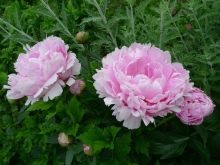


Why transplant?
A peony transplant is necessary. If you do not touch the plant and leave it to grow in its place, then soon you will notice that your handsome man has stopped blooming and turned into an ordinary wild herbaceous bush. The deterioration of varietal properties in peonies occurs 5, and sometimes 7 years after planting. During this time, the peony bushes grow very much - they grow many shoots, which begin to interfere with each other's normal development and receive the proper amount of sunlight. Even if you generously feed an adult plant, then it may stop blooming.
The bush of this perennial must also be renewed for the reason that over the years the area of the root neck is aging. Colonies of ants or slugs often settle there. When transplanting a peony, you will have the opportunity to divide a large old bush into several parts. After such rejuvenation, the plant will begin to release new shoots, and flower buds will appear with them.
It happens that the transplant of a perennial must be carried out in connection with landscape changes or the construction of buildings on the site. In this case, in order not to lose the plant, replanting it in the spring will be better than in the fall.
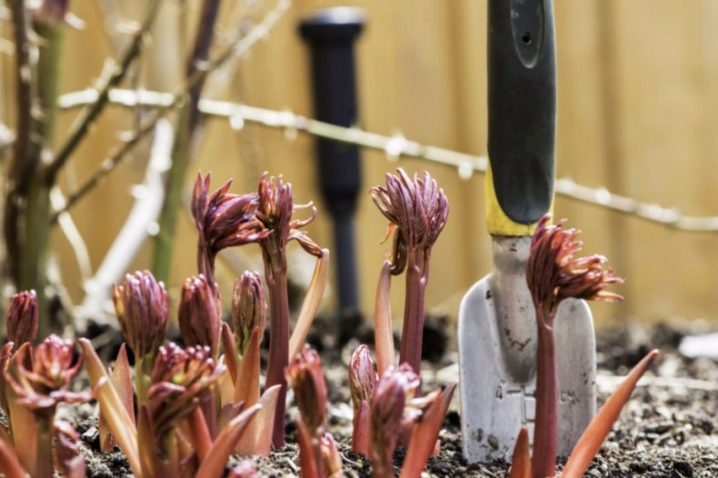
Optimal timing
The best time to transplant peonies is considered the end of August - the beginning of September. At this time, there are still no cold night frosts, gusty winds and prolonged heavy rains. If you need to transplant in spring, then you need to complete this procedure before flowering and active awakening of the buds, in May.
It is important that by the time the bush is transplanted, the snow has completely melted and the period of night frosts has passed.
Gardening experts believe that after a spring transplant, the plant will adapt for a long time, so you will not see its flowering in the next 2 years. But do not delay the transplant, because if you do this at the beginning of summer, then the plant with a high degree of probability may simply die - its roots will not be able to take root under the influence of too bright summer rays of the sun.
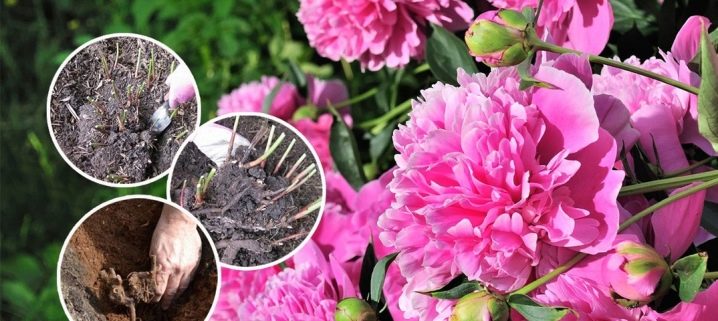
Seat selection
The choice of a new location for transplanting a peony must be approached responsibly.This step will largely determine how successfully the flower can take root and adapt. Peony is a thermophilic perennial, so you need to select for planting such places where the flower will be provided with good lighting. You should choose areas where the air will move freely, but at the same time remember that the peony does not like cold drafts and strong gusts of wind. If you can find a place on your site where the perennial is in partial shade during the daytime, then perhaps this will be the best option for a peony.
Perennial peony bushes are very sensitive to temperature conditions and soil moisture. Try not to plant a perennial where there are capital buildings - because of them, the soil warms up more strongly in summer than in open areas, and the peony does not like overheating. The distance between buildings and perennials should be at least 1.5 m, and preferably 2 m.
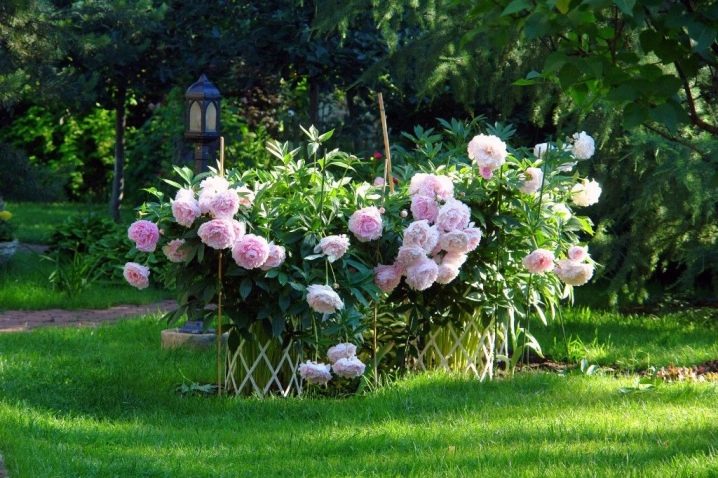
The same distance should be from large trees - this is necessary for the reason that the powerful root system of the tree will take moisture from the peony, and the plant feels bad on dry soils. When choosing a place for planting a peony, find out at what depth groundwater occurs in your area. They should not come closer than 1 m to the ground.
This is quite enough so that the roots of the bush do not rot, since they grow in an adult plant by about 1 m, and then branching begins in the horizontal plane.

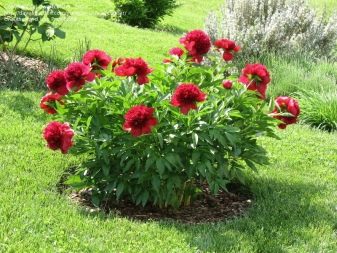
Preparation
After you have decided on a new place of residence for the peony, not only the plant, but also the place for planting must first be prepared for the transplantation procedure. The day before the perennial transplant, you will need to soften the soil around it as much as possible. To do this, the soil near the peony must be watered very abundantly. This manipulation will make it easier to dig out the bush and prevent damage to its root system.
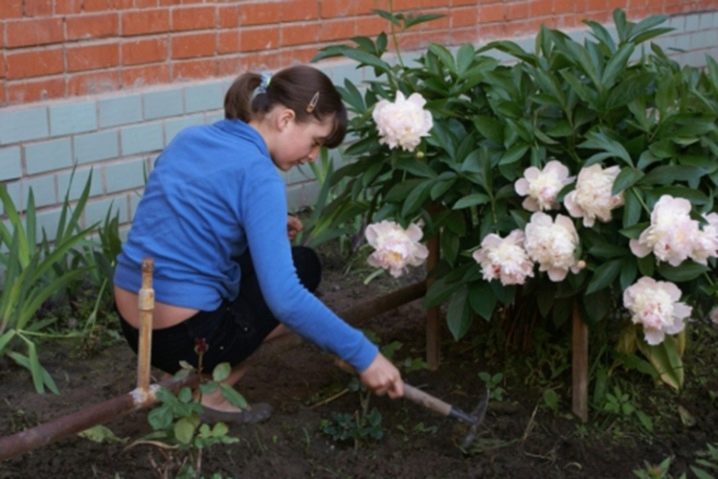
Priming
The best substrate for peonies is loamy soil. If the soil on your site is dense and heavy, it must be loosened by adding coarse river sand. If your area is dominated by sandstone, then add a mixture of clay and compost to the soil substrate. The next step you need to dig a planting hole in the ground measuring 55-70 centimeters in depth and width. If your site is located in a lowland, then a pit is made 75-90 centimeters, increasing it by 20 centimeters in order to equip good drainage. For transplanting several bushes, the distance between the pits is made at least 1 meter.
Now we will arrange the drainage. To do this, a mixture of fine gravel, broken red brick and coarse river sand must be poured at the bottom of the planting pit. The thickness of this layer must be at least 20 centimeters. The next layer will be a nutritious soil substrate, they need to fill up to 50 centimeters of the space of the planting pit. The formula can be prepared using the following recipe:
- peat, leaf humus, turf are taken in equal proportions;
- per plant add 200 grams of superphosphate, 300-400 grams of bone meal and 100-150 grams of potassium sulfate;
- after you placed the resulting substrate in the planting pit, the remaining space is covered with peat with humus; usually this layer is about 10 centimeters.
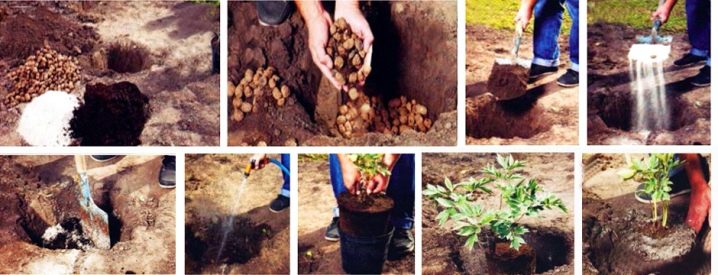
Important! The preparation of the soil in the planting pit should be taken care of 2–4 weeks before the peony is planted. This is done in advance so that the soil has time to settle well, then air pockets will not form during landing.
Peonies
After the soil around the peony bush has softened, you need to cut off the aerial part of the plant, while leaving shoots 10-15 centimeters long. At a distance of 20-25 centimeters, they loosen the soil with a pitchfork, gently swing and remove the bush. After that, you need to manually remove the soil from the roots of the plant and rinse them with warm water. Now the perennial should be left alone and the roots should be allowed to dry for about 3-5 hours in the shade. This must be done so that the upcoming division of the bush is easy and with minimal losses to the roots of the plant.
Examine the root system of the perennial. If you see rotten or damaged roots, immediately remove them with a sharp knife, and dry the cuts, treat first with fungicide and then with charcoal powder. Only after that you can start dividing the bush. Experienced gardeners believe that the bush should be divided in equal parts, but so that at least 2-3 dormant buds remain on each rhizome. Use sterile tools to cut the rhizome - it can be a well-sharpened knife or a small hatchet. All sections must be dried and processed with crushed coal powder or brilliant green solution.
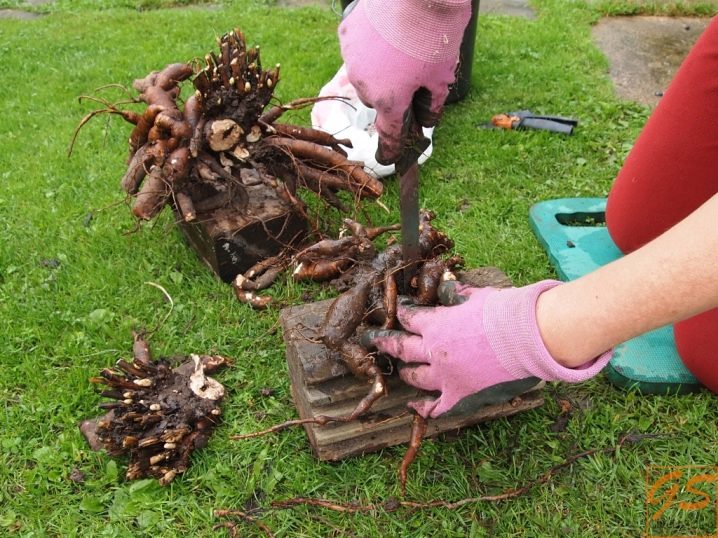
Step-by-step instruction
In order for the peonies to take root well, they must be properly planted in another place. Algorithm actions will be as follows:
- a pit for planting a perennial in a new place must be well watered with settled warm water;
- place the prepared part of the peony in the center of the pit and bury it 5–7 centimeters into the soil, while making sure that all the roots are carefully straightened;
- to enhance the development of the root system, the part of the peony prepared for planting can be treated with stimulating drugs, for example, "Kornevin";
- the soil around the planted bush must be leveled and lightly crushed with your hands;
- now the soil around the bush needs to be mulched with sawdust or leaf humus and watered with warm water;
- when the first sprout appears 4–5 centimeters high, the mulch is removed and the soil is loosened. Instead of mulch, a mixture of peat, manure and Nitrofoska fertilizer is placed around the bush.


In addition to planting peony rhizomes in open ground, some gardeners take a different approach. They plant the prepared parts of the rhizomes in early spring not in the soil, but in large pots and keep them in the basement until the moment when favorable warm weather comes, and the plants have time to take root a little during this time. Already in April, after the snow melts, the pots are moved to the garden and buried in the ground, without removing the plants from the pot. So they grow until the onset of autumn. And only in September, the strengthened peonies are planted in the ground by transferring from the pot to the planting pit prepared in the above way.
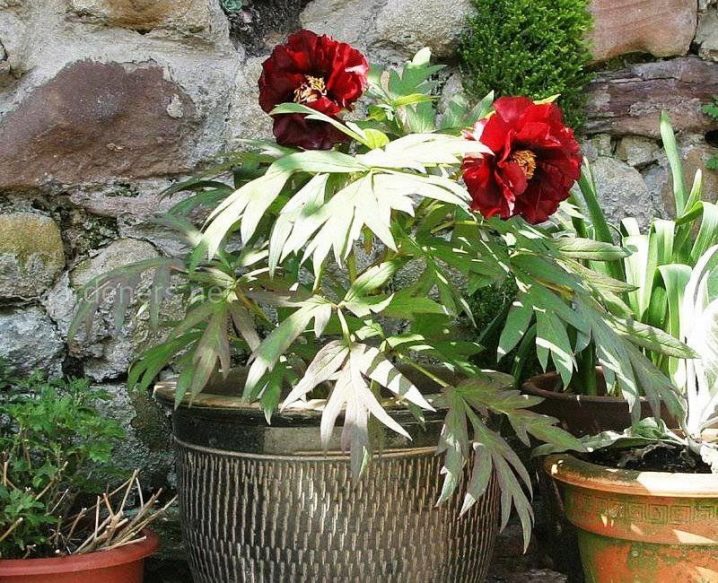
Follow-up care
After the transplanting procedure has been carried out, the peony bushes need to be watered regularly, preventing the soil from drying out. In order for the root system to develop successfully, the ground around the bush must be regularly loosened and mulched. Such a procedure will help the roots to retain moisture around them and will inhibit the growth of weeds. When watering a perennial, you need to try so that water does not get on the leaves and shoots. In order for the plant to direct all its forces towards rooting, it is recommended to remove all the flower buds from the peony at an early stage of their formation for the first two years after transplantation. And only after two years one bud can be left on the bush. As a result of such actions, next year the bush will delight you with its abundant flowering.
After planting, the young plant is especially vulnerable to diseases and pests. In order to prevent infection, the soil near each bush must be disinfected with a solution of potassium manganese. This should be done regularly. After young shoots appear on the bushes, a protective fence is erected for the plant. It is made from pegs and rope. The shoots do not need to be tied up, they will be surrounded at half their height by this fence, which will protect the young fragile peony from the wind.
In autumn, young peonies are covered with covering material and spruce branches to keep them from frost.
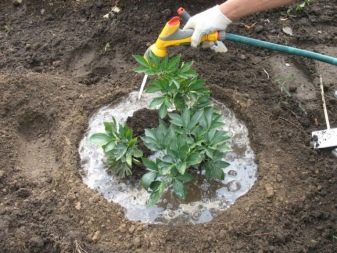

The transplanted peonies are watered in the summer once a week in the evening, when the sun's rays are not so active.In this case, under each bush, you need to pour from 20 to 30 liters of settled water. The first two years after transplantation, the perennial does not need feeding, since the components that were added to the soil when preparing the planting hole are enough for it. After two years, it is necessary to apply complex fertilizers containing phosphorus and potassium under the peony bush... And during the formation of buds, the peony will need to introduce nitrogenous components. Peonies transplanted in spring often suffer from wilting of the lower leaves. This must be monitored and wilted leaves must be removed in time, since they are a breeding ground for pathogens and pests.
Despite the divergence of opinion among gardeners about the timing of transplanting peonies, practice has shown that spring transplantation can be quite successful if, when performing it, you choose the right time, place and carefully prepare the planting material. The subsequent care of the plant also plays an important role in the success of the spring transplant. With careful attention to it - timely watering, mulching the soil and applying fertilizers - the perennial takes root well and over time begins to bloom profusely.
You will learn more about transplanting peonies in the spring in the next video.







































































































The comment was sent successfully.